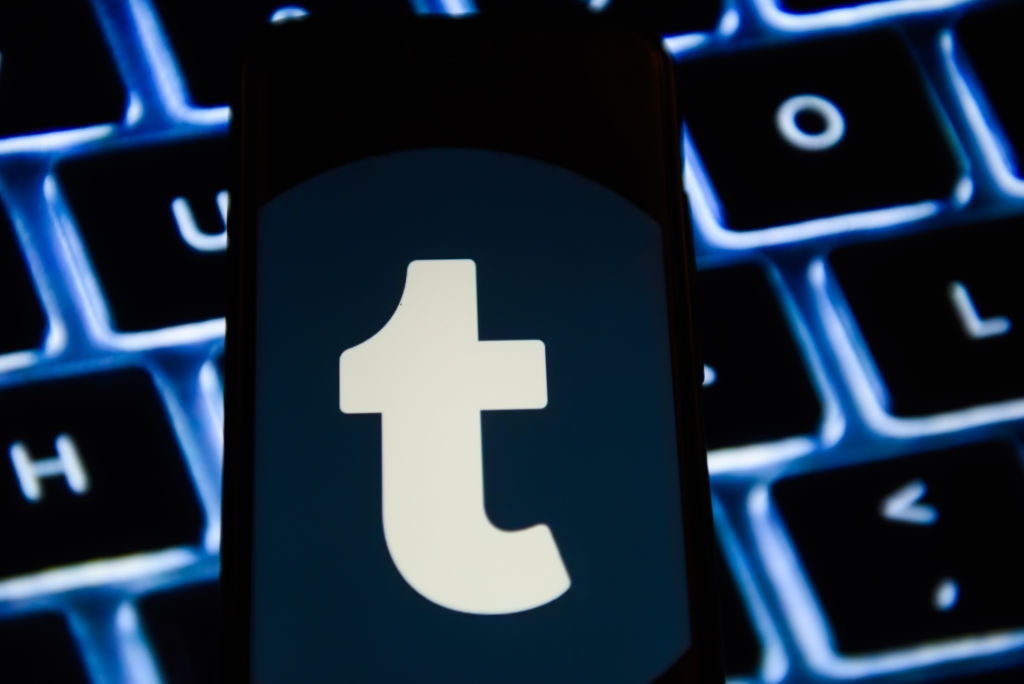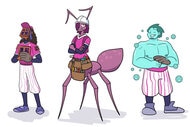Create a free profile to get unlimited access to exclusive videos, sweepstakes, and more!
What does fandom's ultimate online destination look like?

When Tumblr announced that it would be banning NSFW material on December 17, 2018, shock waves rippled through fandom. Some predicted ruin; some predicted just more of the same, with less “female-presenting nipples.”
For fans who had never been through something like this before or who had believed that Tumblr would somehow endure forever, it felt like the end of the (digital) world.
But for fans who had lived through platforms and rightsholders bringing down the hammer at various points in fannish history, it was just the same damn thing all over again — except that this time, we didn’t have a compass.
Fandom loves to build its houses on other people’s property.
Even in the relatively free-for-all analog era, it was rare for us to own our own means of production. A mimeograph machine did not come cheap to the average fan who wanted to produce fanzines themselves. Rather, mimeographs found at local libraries or churches and offset printers found at print shops were used, as well as copy machines at said shop, the library, or one’s place of work.
But once produced, only the cost of postage and the number of subscribers circumscribed your reach. If someone in your fandom didn’t like your zine or the content in it, they might write some frothy editorials shading you and refuse to advertise your zine, but they couldn’t stop you from distributing it. And if the rightsholder disagreed — like Lucasfilm’s stance on any adult Star Wars content — well, then you could just go underground, temporarily or permanently. While fandom during this era functioned as a kind of secret society you could only stumble into at a con, by word of mouth, or in the back of a sci-fi magazine, fans, essentially, could build their own spaces to their own standards.
When computer networking and, later, the Internet got involved, fans did exactly what they were already doing: using the resources available to them for their own ends. In the June 1984 issue of venerable Star Trek letterzine Interstat, one letter writer excitedly informed their fellow fans about a new service they could access through a university’s mainframe computer: Usenet. Usenet’s availability was so tied to the university system that every September saw a regular influx of new users, as incoming students created their own Usenet accounts. That is, every September until 1993, when AOL began offering Usenet access to its users. Fandom on Usenet became more accessible — and more visible.
Unlike the analog days, absolutely anyone could be watching. In a 1999 alt.tv.highlander.creative thread discussing the best Highlander fics, one fan warned others that “[p]osting the urls for personal websites that contain slash can endanger them. There have been slash sites that were pulled by servers because they became too well known. […] For all you know a minor or an irate fundamentalist is reading these posts.”
One solution to that visibility was mailing lists. Websites such as Yahoo! Groups provided the option of an e-mailing list alongside an online discussion board to provide a number of interaction opportunities for fans, as well as groups specifically tailored to unique fandom interests. These message boards often came with the option to lock the group's individual boards and discussions down to everyone save those who requested membership access. As Flourish Klink, the co-host of premiere fandom podcast Fansplaining, remembers, “When I first entered fandom, Usenet was fading out as email groups were becoming more prevalent. Forums were also fairly significant. Interactions varied greatly fandom by fandom — in some fandoms, creators spent time on forums or even email groups, whereas in others there was no contact whatsoever. There was also more opportunity to isolate yourself from creators — a private email group was very unlikely to be infiltrated by someone official.”
During the days of Web 1.0, fans also took advantage of low-cost or free web-hosting services like GeoCities, Tripod, and Angelfire to build their own websites, ranging from personal pages to lovingly and laboriously coded fic archives. In an Internet where everything had to be navigated by hyperlinks, fans utilized webrings to link themselves together. It was unwieldy, especially by Web 2.0 standards, but, for fandom in the late ‘90s and early aughts, it was home.
That is, of course, if The Powers That Be didn’t suddenly decide that your content was suddenly unacceptable. Like Paramount trying to crack down on fanworks shared on Usenet in 1995. Or Fox, Warner Brothers, and Lucasfilm sending cease and desist notices and other threatening communiques to X-Files, Harry Potter, and Star Wars fansites on the grounds of copyright infringement. Or Tripod purging fansites or FanFiction.net purging NC-17 fics (twice!). Or LiveJournal’s infamous Strikethrough and Boldthrough purges.
Or Tumblr’s decision to blanket ban NSFW content entirely.
LiveJournal’s fall from fannish grace didn’t happen all at once; as one fan remembers, these events precipitated a death by a thousand cuts for the platform. This slow lurch towards obsolescence was sad, of course, but it also allowed fans to gracefully transition over to new platforms that were much more appealing to their needs: Tumblr, for its ease of use and native image hosting, and Archive of Our Own, that rare actual bastion of fannish freedom — but specifically designed only for certain formats of fanworks.
But Tumblr’s fall from grace felt sudden. Even though a Tumblr purge the Marvel fandom anointed The Snappening preceded it, it only did so by three months. Tumblr literally served fandom two weeks’ notice. Fans scrambled to archive their Tumblrs, even if they did not post or create NSFW content, because it felt like they could be next. But no matter how many hours you nervously refreshed Tumblr, downloading the backup of your blog, that was just damage control. Once you had your content safely archived, where were you going to take it?
One strange but rarely acknowledged truth about fandom is that once we become accustomed to a certain fannish infrastructure, we rarely look back.
When LiveJournal began to stumble, Dreamwidth, a fan-friendly and fan-owned platform that offered much of the same functionality, opened its doors to fans. Many fans did flock to Dreamwidth, either as a brave new world or just as a backup, but the vast majority relocated to Tumblr, and the rest is history.
To migrating fans and to new fans, many of whom stumbled across fandom thanks to Tumblr’s communal tags, Tumblr was a Web 2.0 social media platform, in contrast to the Web 1.0 blogging platform LiveJournal provided and Dreamwidth promised to continue. After spending the better part of a decade battling with Photobucket (many a picspam were littered with broken images), Tumblr’s native image and, later, video hosting capabilities felt like a divine gift… and then a divine right. While Dreamwidth does offer some image hosting, it’s well below the standard fans have come to expect and rely on for their fanworks.
The only platform that attempts to provide an experience that can compete is Julia Baritz’s Pillowfort, which aims to provide the best of Tumblr and LiveJournal without having to answer to the corporate overlords whose interests propelled the policies that have shown fandom the writing on the wall. It’s a noble goal — and one that may be difficult for Pillowfort, whose staff consists of Baritz and two full-time developers to pull off. In the aftermath of the Tumblr purge, Pillowfort’s user base swelled from 5,357 users on December 14, 2018, to almost 40,000 users the following January. As you can imagine, this placed a lot of strain on their servers, and many Tumblr users who tried to sign up encountered notices that the site was down.
And the platform remains hosted on a domain, .io, that explicitly bans anything sexual or pornographic in nature — just like Tumblr. (Pillowfort has announced plans to move to a new domain.)
Any grassroots effort to create a fandom platform is faced with one truth that may prove to be impossible to clear: the fact that the technological needs of fandom vastly outstrips our viability as a profitable user base on our own. Meredith Levine, a fanthropologist and media consultant, told SYFY FANGRRLS that “scaling out a user base is really hard, and requires more investment than anything that is fandom oriented can do… It’s much easier for […] individual fans to hack platforms that already have users and make what they need than it would be to build something from scratch.”
If a grassroots, fan-oriented platform wants to be the next home for fandom online, it has to find a way to solve that financial problem in order to keep fandom in the lifestyle that it is accustomed to: the support a platform that services much more than fandom can offer. And whatever the next platform is, it has to solve one other major problem: fannish toxicity.
You would need to be dead to have missed the increasingly emotional temperature of Internet discourse. Or maybe a better metaphor is a lobster who doesn’t even realize that they’re boiling until it’s too late.
Tumblr’s legacy will always be inextricable from the toxicity and vitriol fans could utilize the platform to unleash on each other. Fan creators and, occasionally, creators got chased off of the platform for “sins” ranging from creating work involving dark themes to shipping the wrong characters, often co-opting the language of social justice to pursue personal vendettas. On a platform without much support for discussion and little to no privacy support, it was difficult to impossible to have nuanced conversations about difficult topics on your own terms. One fan has even described Tumblr as “Twitter writ large.”
But it would be foolish to think that that toxicity and vitriol is new in fandom. As media scholar and acafan Henry Jenkins said to SYFY FANGRRLS, “[l]iterary science fiction fandom was overwhelmingly masculine until the early 1960s. We know that there was an enormous gender war in the 1960s as women began showing up at science fiction conventions.” But the difference was that, for a very long time in fandom, both those hurling vitriol and those hiding from it could retreat somewhere. “I think those two worlds can coexist because they didn't really cross paths with each other until things went online and then we saw a wave of flame wars in the early '90s,” said Jenkins.
“Vitriol? It's nothing new, but there's a lot more sharing in the open now of what used to be done in locked forums and private message lists,” said self-professed fandom advocate and attorney Heidi Tandy.
But the accessibility and anonymity of modern social media have eliminated that option, and there are just so many more fans actively participating in fandom online these days. “There are vastly more people engaging today than there were 20 years ago,” Klink told SYFY FANGRRLS. “Cast your mind back to early Harry Potter fandom. Back then, even [writer] Cassandra Clare had fewer than 1000 followers on LiveJournal — and she was the biggest name fan around! By comparison, today Cassie has 946k followers on Twitter. Obviously, a lot of that has to do with how she's become a popular published author, but it gives a sense of the order of magnitude by which things have changed. It's one thing to deal with vitriol and even death threats when there's only a few people engaging in that kind of rhetoric — something totally different when there's hundreds or thousands.”
The next fandom platform has to be able to manage both the emotional temperature and the sheer volume of both modern online discourse and modern fandom. And all of this on top of figuring out to provide functionality that requires more resources than modern fandom can provide on their own, even though we are now legion. It’s a tall order, and nothing on the horizon seems like it can take on the task.
In a perfect world, fandom’s ultimate destination might look like a bluesky vision Tandy shared with SYFY FANGRRLS. “I really loved LiveJournal, and I wish something with a similar format existed as a multifandom base now,” said Tandy. “Honestly, I wouldn't mind something like LinkedIn for fandom, where you can blog and get comments — and share others' posts — with scheduled posts, a side column for your tweets/Instagram posts, lock some content to the general public, know how many people are viewing it, and maybe include a slack-chat feature — but also have it wrapped in a protective blanket of fair use so content creation and sharing isn't seen as likely copyright/trademark infringement.”
Jenkins takes a much more macro approach to the problem. “I would say [if] you want to build a fan community, you want to actually have a community structure, not an individual structure. You want something that people feel a sure stake in the long term viability of the social networking exchange. Not ‘me, myself, and I’ at the center, and I think there needs to be enough room for people to articulate and think their way out of disagreement, as has been possible with older internet forums and is harder and harder with these sort of short communication technologies we're working with today.”
But Levine’s much more radical approach offers fandom hope in these post-Tumblr times. “For me,” she said, “the ideal social media platform for fandom isn’t on the internet. I think one of the best examples for me of fandom are Disney theme park fans… When you physically see, and actually share space with, and talk to people who are interested and express their fannish in very different ways… [It] is not necessarily a financially accessible fandom. That's fine. But I think it's really ideal because it forces you to be in those spaces, and witness someone else's joy, and see how people behave, and be quiet, because you can produce stuff, but there isn't a metric on being acknowledged.”
Maybe the silver lining of this strange situation we find ourselves in now, steadying ourselves on aging platforms and platforms circumscribing our activity, is being able to take stock of ourselves and each other. Maybe our destination isn’t a platform, and it never was.
In his essay “The Loser’s Club,” Michael Chabon writes beautifully of the fan’s drive to connect: “Every great record or novel or comic book convenes the first meeting of a fan club whose membership stands forever at one but which maintains chapters in every city — in every cranium — in the world. Art, like fandom, asserts the possibility of fellowship in a world built entirely from the materials of solitude. The novelist, the cartoonist, the songwriter, knows that the gesture is doomed from the beginning but makes it anyway, flashes his or her bit of mirror, not on the chance that the signal will be seen or understood but as if such a chance existed.”
A fandom, after all, cannot be composed of just one person. And we have to remember that we have the power to build them, both online and in person, by connecting with one another honestly, earnestly, respectfully, and enthusiastically about the things that we love. No terms of service required.







![Erin Lefler speaks at an ACE Comic-Con panel in 2019. [Credit: Erin Lefler/ACE]](/sites/syfy/files/styles/media_gallery_next_gallery/public/2020/03/image12.jpg)








